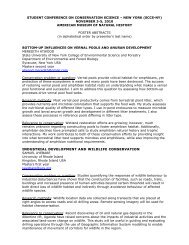SRMP Dynamic Earth Curriculum - American Museum of Natural ...
SRMP Dynamic Earth Curriculum - American Museum of Natural ...
SRMP Dynamic Earth Curriculum - American Museum of Natural ...
Create successful ePaper yourself
Turn your PDF publications into a flip-book with our unique Google optimized e-Paper software.
Science Research Mentoring Program<strong>Dynamic</strong> <strong>Earth</strong>Session Six: Inner <strong>Earth</strong>WORKSHEET: Oxygen Isotope Analysis - Page 2We have a sampling <strong>of</strong> raw (and as <strong>of</strong> now, unpublished!)data from a specimen that was analyzed using theSecondary Isotope Mass Spectrometer (SIMS) in Madison,Wisconsin. We will be looking at data from just four <strong>of</strong> thechondrules.1. In Excel, enter the d18O and d17O values for chondrule2. Do not enter the Opx values.3. As the data is entered, it will be plotted on the graph(with d18O on the horizontal axis and d17O on thevertical axis). Each set <strong>of</strong> data entered has a SeriesName. What name has been given to this series?Series Name:We will be comparing this graph to the graph on page 1, so we want them to have similar scales.Note that the maximum and minimum values on your X and Y-axes correspond roughly to themaximum and minimum values on page 1.4. Give your graph a title and label the axes.Title: Display the Toolbox (icon menu at the top <strong>of</strong> the window). Click within the chart area.Under “Chart Options” in the Toolbox is the “Titles” menu. In the top box, “Chart Title” should beselected. Type “Oxygen Isotopes in Meteorite Chondrules” in the space provided (“click here toadd title”Axis: Now instead <strong>of</strong> “Chart Title,” select “Horizontal (Category) Axis.” Type “delta-18O, relative toSMOW” in the space provided. Select the vertical axis and title it “delta-17O, relative to SMOW.”This graph represents just one tiny portion <strong>of</strong> the meteorite. To get a clearer picture <strong>of</strong> the wholemeteorite, we’ll look at data from some more chondrules.5. Enter the d18O and d17O values for chondrules 6, 9, and 30 under their respective headings. Donot enter the Opx values.6. Once you have graphed the new data, you can compare it to known bodies. Recall that rockswhich form together have similar ratios <strong>of</strong> 17O /16O and 18O /16O. To which (if any) <strong>of</strong> the bodiesrepresented in the graph on page 1 is this new sample most likely related?© 2013 <strong>American</strong> <strong>Museum</strong> <strong>of</strong> <strong>Natural</strong> History. All Rights Reserved. 31
















